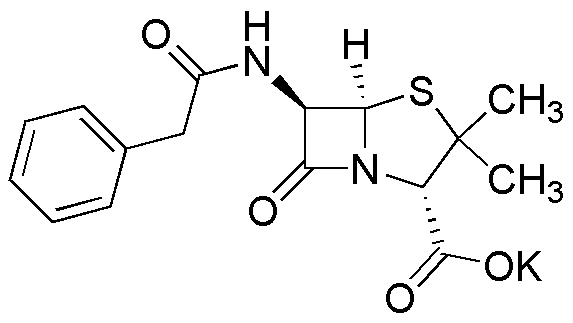Penicillin G potassium salt is widely utilized in research focused on:
- Antibiotic Therapy: It is primarily used in the treatment of bacterial infections, particularly those caused by Gram-positive organisms. This makes it essential in hospitals and clinics for managing infections effectively.
- Pharmaceutical Development: Researchers use it as a standard in the development of new antibiotics and in studies related to antibiotic resistance, helping to ensure the efficacy of new treatments.
- Veterinary Medicine: This compound is also employed in veterinary practices to treat infections in animals, ensuring their health and well-being, which is crucial for livestock and pets alike.
- Laboratory Research: It serves as a critical reagent in microbiological studies, allowing scientists to investigate bacterial growth and resistance patterns, thus contributing to advancements in microbiology.
- Quality Control: In pharmaceutical manufacturing, it is used as a reference standard to ensure the quality and potency of antibiotic products, thus maintaining safety for consumers.
Información general
Propiedades
Seguridad y normativas
Aplicaciones
Penicillin G potassium salt is widely utilized in research focused on:
- Antibiotic Therapy: It is primarily used in the treatment of bacterial infections, particularly those caused by Gram-positive organisms. This makes it essential in hospitals and clinics for managing infections effectively.
- Pharmaceutical Development: Researchers use it as a standard in the development of new antibiotics and in studies related to antibiotic resistance, helping to ensure the efficacy of new treatments.
- Veterinary Medicine: This compound is also employed in veterinary practices to treat infections in animals, ensuring their health and well-being, which is crucial for livestock and pets alike.
- Laboratory Research: It serves as a critical reagent in microbiological studies, allowing scientists to investigate bacterial growth and resistance patterns, thus contributing to advancements in microbiology.
- Quality Control: In pharmaceutical manufacturing, it is used as a reference standard to ensure the quality and potency of antibiotic products, thus maintaining safety for consumers.
Documentos
Hojas de datos de seguridad (HDS)
La SDS proporciona información de seguridad completa sobre la manipulación, el almacenamiento y la eliminación del producto.
Especificación del producto (PS)
La PS proporciona un desglose completo de las propiedades del producto, incluida la composición química, el estado físico, la pureza y los requisitos de almacenamiento. También detalla los rangos de calidad aceptables y las aplicaciones previstas del producto.
Certificados de análisis (COA)
Busque certificados de análisis (COA) ingresando el número de lote del producto. Los números de lote y de partida se pueden encontrar en la etiqueta de un producto después de las palabras "Lote" o "Lote".
Número de catálogo
Número de lote/lote
Certificados de origen (COO)
Este certificado de origen confirma el país en el que se fabricó el producto y también detalla los materiales y componentes utilizados en él y si se deriva de fuentes naturales, sintéticas u otras fuentes específicas. Este certificado puede ser necesario para cumplir con las normativas aduaneras, comerciales y regulatorias.
Número de catálogo
Número de lote/lote
Hojas de datos de seguridad (HDS)
La SDS proporciona información de seguridad completa sobre la manipulación, el almacenamiento y la eliminación del producto.
DownloadEspecificación del producto (PS)
La PS proporciona un desglose completo de las propiedades del producto, incluida la composición química, el estado físico, la pureza y los requisitos de almacenamiento. También detalla los rangos de calidad aceptables y las aplicaciones previstas del producto.
DownloadCertificados de análisis (COA)
Busque certificados de análisis (COA) ingresando el número de lote del producto. Los números de lote y de partida se pueden encontrar en la etiqueta de un producto después de las palabras "Lote" o "Lote".
Número de catálogo
Número de lote/lote
Certificados de origen (COO)
Este certificado de origen confirma el país en el que se fabricó el producto y también detalla los materiales y componentes utilizados en él y si se deriva de fuentes naturales, sintéticas u otras fuentes específicas. Este certificado puede ser necesario para cumplir con las normativas aduaneras, comerciales y regulatorias.


